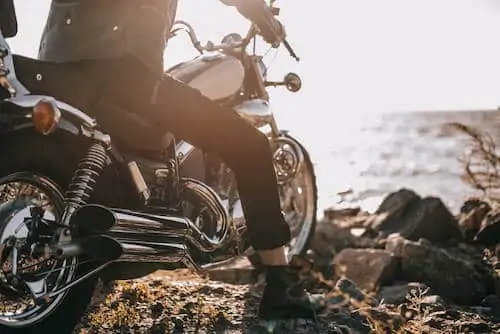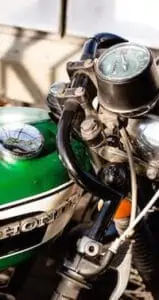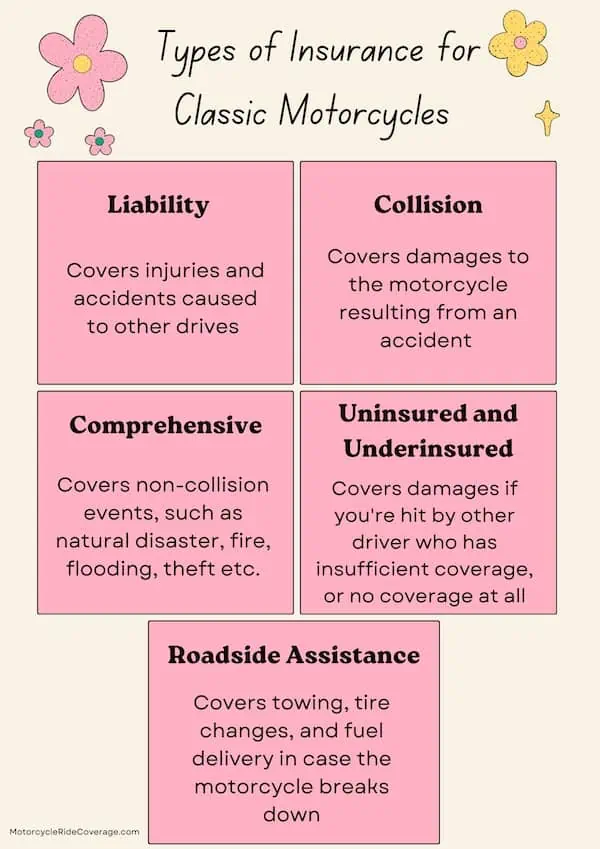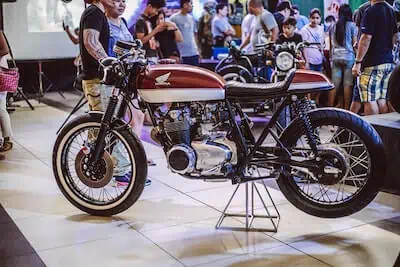Motorcycles from an earlier era are fun to ride. When you own a vintage bike, you add a bit of nostalgia to the experience.
You might be a collector or someone who has owned their motorcycle since you can remember. Either way, knowing how to insure your bike property ensures your finances receive appropriate protection.
Didn't You Try Our Quote Comparison Tool Yet? Save BIG by Doing it!
Table of Content
- How Old Does a Motorcycle Need to Be to Be Considered Classic?
- What Is the Difference Between Classic and Vintage Motorcycles?
- What If I Have a Veteran Motorcycle?
- What Is Classic Motorcycle Insurance?
- What Are the Different Insurance Types for Classic Motorcycles?
- How to Determine Valuation for Classic Motorcycle Insurance
- Additional Classic Motorcycle Insurance Options to Consider
- How Much Does Classic Motorcycle Insurance Cost?
- Do I Need Insurance for a Vintage Motorcycle?
- Is There Vintage Motorcycle Insurance For My Accessories?
- What About Insurance for Antique, Non-Running Motorcycles?
How Old Does a Motorcycle Need to Be to Be Considered Classic?
Classic motorcycles are typically 25 years old or older. They continue to look like they were when the bikes came off the factory line.
The motorcycle should be in a near-original condition to receive the classic designation. If it needs aftermarket parts or uses something other than OEM items for repairs, the bike might need to wait for a “vintage” designation.
Custom motorcycles built or rebuilt with fabricated parts replicating the original factory release can sometimes qualify as classic bikes. The mods used for this construction can also put it into this category.
You’ll need to receive an official ruling from your insurer to determine what policies are required to protect your financial interests. Since customized parts and the labor to repair them can be significant, there could be a large price difference between a classic and a custom motorcycle.
What Is the Difference Between Classic and Vintage Motorcycles?
Classic and vintage motorcycles share many of the same qualities, but one critical difference distinguishes them from each other.
If your motorcycle is at least 25 years old, designed after World War II, and created with high-quality construction, it likely qualifies as a classic. Numerous brands meet this distinction, including Indian, Harley-Davidson, and Honda.
When your motorcycle meets those stipulations and incorporates heavy customization, it is a vintage bike instead of a classic.
Anyone over 35 could have a motorcycle classified as an antique, although some insurers don’t offer that classification.
What If I Have a Veteran Motorcycle?
“Veteran” is a term used in the United Kingdom to describe a motorcycle built before 1915. Any older models made after January 1, 1915, are considered vintage.
“Classic” isn’t an official term but is often used to describe motorcycle coverage when insurance is needed for older bikes. The only official designation is “vintage.”
The American Historic Racing Motorcycle Association defines a vintage bike as one built before 1975 or after that year if it was created for road racing.
Some states allow motorcycles to be licensed and registered as antiques after only 20 years, even if the standard “historical” term applies to those built 35 years ago or later.
What Is Classic Motorcycle Insurance?
Classic motorcycle insurance considers your bike’s unique circumstances when operating on public roads. Since it may be more challenging to locate OEM parts or find a mechanic, the different cost elements create other coverage structures than what you’d find with standard motorcycle insurance.
You still get the liability insurance or proof of financial responsibility required for motorcycles when operating on public roads. Classics typically need more comprehensive collision coverage because of their age. Without the latter options (often optional), you’d be on the hook for any repair or parts expenses.
What Are the Different Insurance Types for Classic Motorcycles?
Classic motorcycles are prized possessions for many enthusiasts, and protecting them with insurance is crucial. Here are some common types of insurance that owners may consider for safeguarding their investments.
Liability Insurance
This insurance option covers injuries or damages caused by a classic motorcycle when it affects other people or properties. It is generally accessed when you are ruled at fault for an accident or a collision.
Collision Insurance
With this option, you have a policy that covers damages to the motorcycle resulting from an accident with another vehicle or object.
Comprehensive Insurance
Although collisions and accidents can cause damage to classic motorcycles, your equipment can be affected by issues outside of those categories. This insurance option protects non-collision events, including natural disasters, fire, flooding, and theft.
Uninsured and Underinsured Policies
This type of insurance covers the policyholder’s damages if they are in an accident with someone (motorcyclist or driver) who doesn’t have enough in their coverage to fulfill their responsibilities.
Roadside Assistance
Roadside assistance provides services such as towing, tire changes, and fuel delivery in case the motorcycle breaks down.
If your bike is disabled and cannot be driven, this insurance option can arrange a tow truck to transport the motorcycle to a repair shop or another location. Service providers can extricate bikes, provide routing services, or jump-start the battery.
These options are similar to what you’ll receive for a motorcycle insurance quote with a modern bike. Although full coverage isn’t necessary if you aren’t financing the purchase, it helps to have this protection because of the enhanced value or difficulty in finding parts when your model is over two decades old.
How to Determine Valuation for Classic Motorcycle Insurance
Most insurance companies provide classic motorcycle coverage quotes online. This result differs from what vintage cars typically receive
You receive an estimate for a classic bike based on the insurer’s internal valuation for your specific bike. Some insurers might ask you to declare an amount you both mutually agree is acceptable.
Bikers typically receive the option for agreed value insurance with collector and classic bikes, although some vintage ones may qualify. You’ll be asked to provide an appraisal or have an independent third party deliver this information.
The insurer decides if the requested amount is appropriate. If the company agrees with your evaluation, they’ll cover the bike for that amount. Classics usually have few modifications, and they typically use the NADA Motorcycle Appraisal Guide or similar publications to approximate the bike’s value.
Agreed value benefits classic and vintage bikes because it enables more coverage when a motorcycle receives a low valuation or estimate from the insurer. It can also be a disadvantage because you’ll overpay for unnecessary coverage if the valuation is incorrect.
If you are unsure of your classic bike’s value right now, it helps to receive a professional appraisal before finding an insurance policy.
Additional Classic Motorcycle Insurance Options to Consider
Operating a classic bike could be challenging to find OEM parts when repairs are necessary. Some insurers provide coverage to ensure you receive original equipment manufacturer parts if that’s what the motorcycle had before a covered incident.
When you have custom parts on the motorcycle, this coverage will replace those items.
If you have custom accessories, parts, or equipment, you may want collision and comprehensive policies to qualify for accessories coverage. This option could also be included in your quote, so it helps to take the time to review each category in its entirety to ensure you have what you need.
How Much Does Classic Motorcycle Insurance Cost?
Your insurance policy costs depend on how often you ride your motorcycle, the coverage limits, driving record, and other factors.
Where you live can also affect how much your insurance expenses are each year.
National insurers like Progressive, Geico, and Allstate provide policies for some motorcyclists for as little as $75 per year. Lower costs typically indicate less coverage, so you’ll want to think about what you’d need financially should your classic bike suffer a total loss.
Although smaller agencies might offer lower rates, Progressive, Geico, and Allstate have the expertise, size, and capabilities to handle your claims efficiently.
The average cost of motorcycle insurance in the United States is about $800 annually, but classic, vintage, and antique options can cost three times that amount. If you require an SR-22 certificate, it could top $5,000. That’s why it helps to contact at least three agencies for an online quote.
Do I Need Insurance for a Vintage Motorcycle?
Anyone riding a vintage motorcycle on public streets is subject to local insurance requirements and operating laws.
Most states require you to show proof of insurance coverage to register the motorcycle. That includes personal property and bodily injury liability. Even if you only take the bike out a few times yearly, insurance is required to ride it legally.
This principle applies to all motorcycles and two-wheel vehicles, including vintage scooters and mopeds.
If you have a vintage bike with numerous mods, it helps to have collision and comprehensive insurance available. These coverage choices cover replacing or repairing a motorcycle when it is stolen or damaged. Some insurers allow the coverage to be extended to a sidecar or select a multi-bike policy.
Those who ride vintage motorcycles regularly might consider medical payment coverage. It’s typically optional, kicking into paying your medical bills if a crash occurs.
Even if you don’t drive a vintage bike, the benefits of comprehensive insurance coverage are worth considering. If someone steals your motorcycle or it’s damaged while transporting it to a show, you wouldn’t have financial protections available without it.
Is There Vintage Motorcycle Insurance For My Accessories?
Most vintage and classic motorcycle insurance policies typically offer replacement funds for accessories, including safety gear, if they are damaged due to a collision or stolen. For this benefit to apply, carried contents coverage is typically necessary.
Check with your insurer about what carried contents options are available. It might come as a standard part of your vintage motorcycle insurance or need to be purchased separately
Accessories coverage comes with the same claim limits as you’ll find for liability, collision, and comprehensive policies. A typical coverage cap is between $2,000 to $3,000, although that amount might only be enough to replace a vintage jacket.
Higher limits could be available, but you’d need to request them during the quote.
What About Insurance for Antique, Non-Running Motorcycles?
If you have an antique motorcycle that doesn’t see time on the road, you don’t need to purchase liability insurance related to a riding.
Even though the bike doesn’t run, you might consider comprehensive coverage for your antique motorcycle. This option protects against storage-related damage, including fires, floods, vandalism, and theft.
Your homeowners’ insurance doesn’t usually cover vehicles, even if you’re a collector.
Some insurance companies offer collector motorcycle insurance for this specific need. You can always upgrade your coverage if you can get the bike running and want to take it out on the road at a later time
Classic motorcycle insurance protects your bike from unexpected events. You can either repair the damage or reduce your risks of financial loss. Without this coverage, any issues related to the equipment would need to be paid out-of-pocket.
Use This Tool for Free and Save on Quotes!





